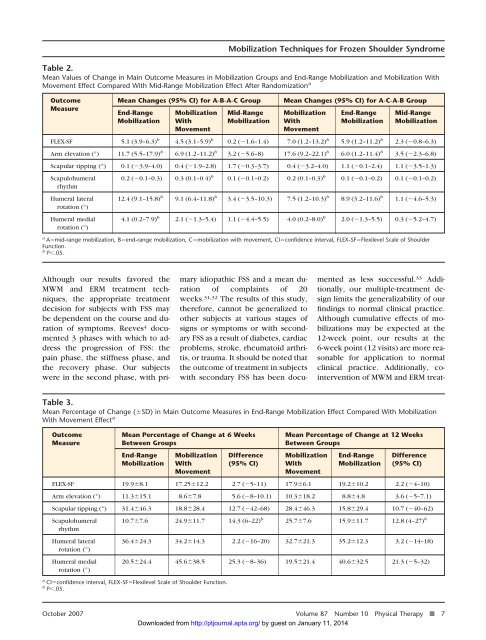Mobilization Techniques in Subjects With Frozen Shoulder ...
Mobilization Techniques in Subjects With Frozen Shoulder ...
Mobilization Techniques in Subjects With Frozen Shoulder ...
You also want an ePaper? Increase the reach of your titles
YUMPU automatically turns print PDFs into web optimized ePapers that Google loves.
Table 2.<br />
Mean Values of Change <strong>in</strong> Ma<strong>in</strong> Outcome Measures <strong>in</strong> <strong>Mobilization</strong> Groups and End-Range <strong>Mobilization</strong> and <strong>Mobilization</strong> <strong>With</strong><br />
Movement Effect Compared <strong>With</strong> Mid-Range <strong>Mobilization</strong> Effect After Randomization a<br />
Outcome<br />
Measure<br />
Mean Changes (95% CI) for A-B-A-C Group<br />
End-Range<br />
<strong>Mobilization</strong><br />
<strong>Mobilization</strong><br />
<strong>With</strong><br />
Movement<br />
Mid-Range<br />
<strong>Mobilization</strong><br />
Mean Changes (95% CI) for A-C-A-B Group<br />
<strong>Mobilization</strong><br />
<strong>With</strong><br />
Movement<br />
End-Range<br />
<strong>Mobilization</strong><br />
Mid-Range<br />
<strong>Mobilization</strong><br />
FLEX-SF 5.1 (3.9–6.3) b 4.5 (3.1–5.9) b 0.2 (1.6–1.4) 7.0 (1.2–13.2) b 5.9 (1.2–11.2) b 2.3 (0.8–6.3)<br />
Arm elevation (°) 11.7 (5.5–17.9) b 6.9 (1.2–11.2) b 3.2 (5.6–8) 17.6 (9.2–22.1) b 6.0 (1.2–11.4) b 3.5 (2.3–6.8)<br />
Scapular tipp<strong>in</strong>g (°) 0.1 (3.9–4.0) 0.4 (1.9–2.8) 1.7 (0.3–3.7) 0.4 (3.2–4.0) 1.1 (0.1–2.4) 1.1 (3.5–1.3)<br />
Scapulohumeral<br />
rhythm<br />
Humeral lateral<br />
rotation (°)<br />
Humeral medial<br />
rotation (°)<br />
<strong>Mobilization</strong> <strong>Techniques</strong> for <strong>Frozen</strong> <strong>Shoulder</strong> Syndrome<br />
0.2 (0.1–0.3) 0.3 (0.1–0.4) b 0.1 (0.1–0.2) 0.2 (0.1–0.3) b 0.1 (0.1–0.2) 0.1 (0.1–0.2)<br />
12.4 (9.1–15.8) b 9.1 (6.4–11.8) b 3.4 (3.5–10.3) 7.5 (1.2–10.3) b 8.9 (3.2–11.6) b 1.1 (4.6–5.3)<br />
4.1 (0.2–7.9) b 2.1 (1.3–5.4) 1.1 (4.4–5.5) 4.0 (0.2–8.0) b 2.0 (1.3–5.5) 0.3 (5.2–4.7)<br />
a Amid-range mobilization, Bend-range mobilization, Cmobilization with movement, CIconfidence <strong>in</strong>terval, FLEX-SFFlexilevel Scale of <strong>Shoulder</strong><br />
Function.<br />
b P.05.<br />
Although our results favored the<br />
MWM and ERM treatment techniques,<br />
the appropriate treatment<br />
decision for subjects with FSS may<br />
be dependent on the course and duration<br />
of symptoms. Reeves 4 documented<br />
3 phases with which to address<br />
the progression of FSS: the<br />
pa<strong>in</strong> phase, the stiffness phase, and<br />
the recovery phase. Our subjects<br />
were <strong>in</strong> the second phase, with primary<br />
idiopathic FSS and a mean duration<br />
of compla<strong>in</strong>ts of 20<br />
weeks. 31,32 The results of this study,<br />
therefore, cannot be generalized to<br />
other subjects at various stages of<br />
signs or symptoms or with secondary<br />
FSS as a result of diabetes, cardiac<br />
problems, stroke, rheumatoid arthritis,<br />
or trauma. It should be noted that<br />
the outcome of treatment <strong>in</strong> subjects<br />
with secondary FSS has been documented<br />
as less successful. 33 Additionally,<br />
our multiple-treatment design<br />
limits the generalizability of our<br />
f<strong>in</strong>d<strong>in</strong>gs to normal cl<strong>in</strong>ical practice.<br />
Although cumulative effects of mobilizations<br />
may be expected at the<br />
12-week po<strong>in</strong>t, our results at the<br />
6-week po<strong>in</strong>t (12 visits) are more reasonable<br />
for application to normal<br />
cl<strong>in</strong>ical practice. Additionally, co<strong>in</strong>tervention<br />
of MWM and ERM treat-<br />
Table 3.<br />
Mean Percentage of Change (SD) <strong>in</strong> Ma<strong>in</strong> Outcome Measures <strong>in</strong> End-Range <strong>Mobilization</strong> Effect Compared <strong>With</strong> <strong>Mobilization</strong><br />
<strong>With</strong> Movement Effect a<br />
Outcome<br />
Measure<br />
Mean Percentage of Change at 6 Weeks<br />
Between Groups<br />
End-Range<br />
<strong>Mobilization</strong><br />
<strong>Mobilization</strong><br />
<strong>With</strong><br />
Movement<br />
Difference<br />
(95% CI)<br />
Mean Percentage of Change at 12 Weeks<br />
Between Groups<br />
<strong>Mobilization</strong><br />
<strong>With</strong><br />
Movement<br />
End-Range<br />
<strong>Mobilization</strong><br />
Difference<br />
(95% CI)<br />
FLEX-SF 19.98.1 17.2512.2 2.7 (5–11) 17.96.1 19.210.2 2.2 (4–10)<br />
Arm elevation (°) 11.315.1 8.67.8 5.6 (8–10.1) 10.318.2 8.84.8 3.6 (5–7.1)<br />
Scapular tipp<strong>in</strong>g (°) 31.446.3 18.828.4 12.7 (42–68) 28.446.3 15.829.4 10.7 (40–62)<br />
Scapulohumeral 10.77.6 24.911.7 14.3 (6–22) b 25.77.6 15.911.7 12.8 (4–27) b<br />
rhythm<br />
Humeral lateral 36.424.3 34.214.3 2.2 (16–20) 32.721.3 35.212.3 3.2 (14–18)<br />
rotation (°)<br />
Humeral medial<br />
rotation (°)<br />
20.524.4 45.638.5 25.3 (8–36) 19.521.4 40.632.5 21.3 (5–32)<br />
a CIconfidence <strong>in</strong>terval, FLEX-SFFlexilevel Scale of <strong>Shoulder</strong> Function.<br />
b P.05.<br />
October 2007 Volume 87 Number 10 Physical Therapy f 7<br />
Downloaded from http://ptjournal.apta.org/ by guest on January 11, 2014
















